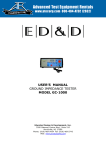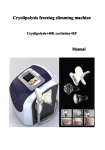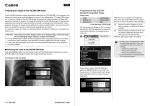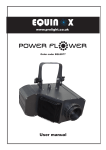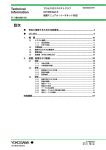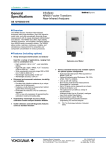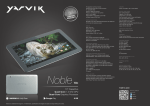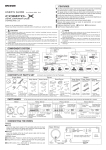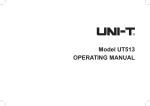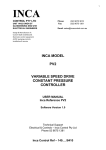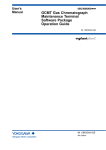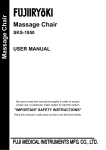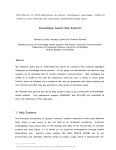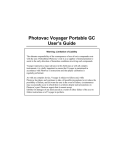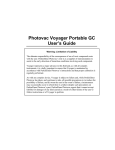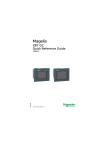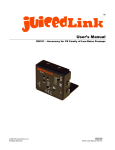Download Introduction
Transcript
Technical Information Process Gas Chromatograph GC1000 MarkII Installation Manual (Ethernet version) TI 11B03A03-03E Contents u Notice..............................................................................................................2 u Introduction....................................................................................................4 1. Overview.......................................................................................................11 1.1 2. System Configuration........................................................................................ 11 1.1.1 Wiring and Piping Diagram.................................................................. 12 1.1.2 External Dimensions............................................................................ 16 1.2 Auxiliary Provisions........................................................................................... 24 1.3 Necessary Operation Conditions for Gases.................................................... 25 1.4 Standard Performance....................................................................................... 26 1.5 Data Plate for ATEX (CENELEC)........................................................................ 28 Installation, Piping, and Wiring................................................................. 29 2.1 2.2 2.3 Installation........................................................................................................... 29 2.1.1 Analyzer Installation............................................................................. 29 2.1.2 Installation of Auxiliary Provisions........................................................ 31 Piping................................................................................................................... 34 2.2.1 General Notes on Piping Work............................................................ 34 2.2.2 Types of Piping..................................................................................... 34 2.2.3 Piping Connection................................................................................ 35 Wiring................................................................................................................... 37 2.3.1 General Cautions on Wiring................................................................. 37 2.3.2 Kinds of Wiring..................................................................................... 37 2.3.3 Recommended Cables........................................................................ 38 2.3.4 Precautions on Wiring.......................................................................... 39 2.3.5 Cable Inlet Locations........................................................................... 43 2.3.6 Connecting Power Cable and Grounding............................................ 44 2.3.7 Connecting Process I/O Signals.......................................................... 53 Revision Information............................................................................................ 63 Yokogawa Electric Corporation 2-9-32, Nakacho, Musashino-shi, Tokyo, 180-8750 Japan Tel.: 81-422-52-5617 Fax.: 81-422-52-6792 TI 11B03A03-03E ©Copyright Oct. 2001(YK) 3rd Edition Oct. 2011(YK) Introduction Notice u This Manual is to provide the technical information for installing a GC1000 MarkII at site. When installing or checking up the installation of GC1000 MarkII, read this sentence carefully. l Regarding This Manual 1. This Manual should be passed on to the end user. 2. Read this manual carefully and fully understand how to operate this product before you start operation. 3. All rights reserved. No part of this manual may be reproduced in any form without Yokogawa’s written permission. 4. Great effort has been expended to ensure that the descriptions in this manual are correct. Should you, however, come across a questionable area or note an inconsistency, a telephone call or letter to Yokogawa Co., Ltd. noting the questionable area would be highly appreciated. 5. The contents of this manual are subject to change without prior notice. l Regarding Protection, Safety, and Prohibition Against Unauthorized Modification. 1. For the protection and safe use of the product and the system controlled by it, be sure to follow the instructions on safety described in this manual when handling the product. In addition, if you handle the product in contradiction to these instructions, our company does not guarantee safety. 2. The following safety symbol marks are used on the product concerned or in this Manual: WARNING A WARNING sign denotes a hazard. It calls attention to procedure, practice, condition or the like, which, if not correctly performed or adhered to, could result in injury or death of personnel. CAUTION A CAUTION sign denotes a hazard. It calls attention to a procedure, practice, condition or the like, which, if not correctly performed or adhered to, could result in damage to or destruction of part or all of the product. IMPORTANT: Indicates that operating the hardware or software in this manner may damage it or lead to system failure. NOTE: Draws attention to information essential for understanding the operation and features. TIP: Gives information that complements the present topic. TI 11B03A03-03E Oct. 11, 2011-00 Introduction See Also: Gives the reference locations for further information on the topic. Protective ground terminal: In order to provide protection against electrical shock in case of a fault. This symbol indicates that the terminal must be connected to ground prior to operation of equipment. Function ground terminal: In order to provide protection against noise. This symbol indicates that the terminal must be connected to ground prior to operation of equipment. 3. If protection/safety circuits are to be used for the product or the system controlled by it, they should be installed outside of the product. 4. When you replace parts or consumables of the product, use those specified by our company. 5. Do not modify the product l Exemption from Responsibility 1. Yokogawa Electric Corporation does not make any warranties regarding the product except those mentioned in the WARRANTY that is provided separately. 2. Yokogawa Electric Corporation assumes no liability to any party for any loss or damage, direct or indirect, caused by the use or any unpredictable defect of the product. TI 11B03A03-03E Oct. 11, 2011-00 Introduction Introduction u Thank you for purchasing the GC1000 MarkII process gas chromatograph. This manual describes the installation of Model GC1000E/GC1000T/GC1000C/GC1000W/ GC1000D/GC1000S (Hereafter, it is abbreviated as GC1000 MarkII) Process Gas Chromatograph. Please read the following respective documents before installing and using the GC1000 MarkII system. l Documents Related to the GC1000 MarkII Process Gas Chromatograph 1. User’s manuals The product comes with the following user’s manuals. n User’s manuals that do not depend upon the specifications of the product (1) Overview (IM 11B03A03-01E) (2) Basic Operation and Startup (IM 11B03A03-02E) (3) Technical Guide (IM 11B03A03-03E) (4) Maintenance and Inspection Manual (IM 11B03A03-04E) (5) LCD Panel Operation Manual (IM 11B03A03-05E) (6) Alarm Message Manual (IM 11B03A03-06E) (7) Password Manual (IM 11B03A03-07E) (8) Installation Manual (Ethernet version) (TI 11B03A03-03E) (This manual) n User’s manuals that depend upon the specifications of the product (1) GCMT Gas Chromatograph Maintenance Terminal Software Package Operation Guide (IM 11B03G03-03E) (2) Capture It! Manual (IM 11B3G1-02E) n User’s manuals for related products (1) PCAS PC Analyzer Server Software (IM 11B06B01-01E) (2) ASET Analyzer Server Engineering Terminal Software (IM 11B06C01-01E) (3) GCET GC Engineering Terminal Software (IM 11B06D01-01E) (4) ASGW Analyzer Server Gateway (IM 11B06E01-01E) (5) ASIU Analyzer Server Interface Unit Software (IM 11B06F01-01E) (6) ANABUS Ethernet system Redundancy Setting Manual (TI 11B03A03-14E) 2. Operation Data Operation data is supplied with the operation manuals in the delivered package and contains the following required to use the gas chromatographs. • • • • • • Process conditions and measurement range Instrument specifications and operating conditions Standard sample for calibration Column system and column Miscellaneous data Chromatogram, base line, repeatability, power supply voltage variation, etc. Analyzer flow diagram and installation TI 11B03A03-03E Oct. 11, 2011-00 Introduction • Parts composition table • General connection diagram • Sampling system diagram (only if supplied by Yokogawa) l General Precautions WARNING (1) In order to analyze gases, process gas chromatographs use a sample of the process gas and utility gases. Since these gases are typically combustible, combustion-sustaining, toxic, odorous, resolvable, polymerizing, or corrosive, refer to the “Safety Information” in our approval drawings and others to ensure safety thoroughly before using these analyzers. (2) Up to two protection systems, each of which weighs approximately 10 kg, are installed on top of the GC1000 Mark II. Therefore, the center of gravity is higher than the center of the analyzer body. Take great care when carrying and installing (piping- wiring) the GC1000 Mark II. The GC1000 Mark II must be carried and installed very carefully (including piping and wiring) by more than one person (at least four people are recommended). (3) Since the GC1000 Mark II are precision instruments, take care when handling not to jolt of knock them. (4) Use the GC1000 Mark II within the range of your purchase specifications. Yokogawa assumes no responsibility for problems resulting from use by the customer outside the purchase specifications. If the GC1000 Mark II need to be modified or repaired, please contact your nearest Yokogawa representative. Yokogawa assumes no responsibility for results where the customer or any third party has attempted to modify or repair these products. (5) LCD panel shoud be operated after discharging static electrocity. Static may damage LCD panel. (6) In case of wiring certificated TIIS, the attached sealing fittings or flameproof packing adapter should be used. Otherwise, it does not comply with TIIS explosion protection. (7) EMC Conformity Standards EN61326-1 Class A, Table 2 (For use in industrial locations) EN61323-2-3 EN61000-3-2 CAUTION: This instrument is a Class A product, and it is designed for use in the industrial environment. Please use this instrument in the industrial environment only. IMPORTANT: (1) Read the attached instruction manual before operating the GC1000 Mark II. (2) The instruments must be installed and operated according to the installation manual, instruction manual, approval drawings, and operation data. TI 11B03A03-03E Oct. 11, 2011-00 Introduction l CAUTIONS OF USING EXPLOSION-PROTECTION INSTRUMENTS The GC1000 Mark II Process Gas Chromatographs are designed to protect against explosion. When these analyzers are used in a hazardous area, observe the following precautions. Since the applicable standard differs depending on the specifications of the analyzer to be used, check the specifications of your analyzer. (1) Kinds of explosion protection To assure explosion protection, the GC1000 Mark II Process Gas Chromatographs have a pressurized and flameproof construction, or type X purging and explosionproof construction meeting the following standards : <GC1000E / GC1000T> FM Type X purging and Explosionproof for CLI, DIV1, GPS B, C & D, NEMA3R Type Y purging and Type X purging for CLI, DIV1, GPS B, C & D, NEMA3R • T1 (programmed-temperature oven 320°C max., isothermal oven 225°C max., liquidsample valve 250°C max.) • T2 (programmed-temperature oven 225°C max., isothermal oven 225°C max., liquidsample valve 225°C max.) • T3 (programmed-temperature oven 145°C max., isothermal oven 145°C max., liquidsample valve 145°C max.) • T4 (programmed-temperature oven 95°C max., isothermal oven 95°C max., liquid-sample valve 95°C max.) CSA Type X purging and Explosionproof for CLI, DIV1, GPS B, C & D, TYPE3R Type Y purging and Type X purging for CLI, DIV1, GPS B, C & D, TYPE3R • T1 (programmed-temperature oven 320°C max., isothermal oven 225°C max., liquidsample valve 250°C max.) • T2 (programmed-temperature oven 225°C max., isothermal oven 225°C max., liquidsample valve 225°C max.) • T3 (programmed-temperature oven 145°C max., isothermal oven 145°C max., liquidsample valve 145°C max.) • T4 (programmed-temperature oven 95°C max., isothermal oven 95°C max., liquid-sample valve 95°C max.) <GC1000C / GC1000W> ATEX (CENELEC) certified : Group II Category 2G, KEMA 98ATEX4675 • EEx pd II B +H2 T1 (programmed-temperature oven 320°C max, isothermal oven 225°C max., liquid-sample valve 250°C max.) • EEx pd II B +H2 T2 (programmed-temperature oven 225°C max, isothermal oven 225°C max., liquid-sample valve 225°C max.) • EEx pd II B +H2 T3 (programmed-temperature oven 145°C max, isothermal oven 145°C max., liquid-sample valve 145°C max.) • EEx pd II B +H2 T4 (programmed-temperature oven 95°C max, isothermal oven 95°C max., liquid-sample valve 95°C max.) TI 11B03A03-03E Oct. 11, 2011-00 Introduction <GC1000D / GC1000S> TIIS (The Technology Institution of Industrial Safety) • Expd IIB + H2 T1 (programmed-temperature oven 320°C max., isothermal oven 225°C max., liquid-sample valve 250°C max.) • Expd IIB + H2 T2 (programmed-temperature oven 225°C max., isothermal oven 225°C max., liquid-sample valve 225°C max.) • Expd IIB + H2 T3 (programmed-temperature oven 145°C max., isothermal oven 145°C max., liquid-sample valve 145°C max.) • Expd IIB + H2 T4 (programmed-temperature oven 95°C max., isothermal oven 95°C max., liquid-sample valve 95°C max.) (2) Precautions for Explosionproof section (The analyzer with optional code "FM/CSA Type Y purging" does not have the explosionproof section.) When handling the screws on the cover of the Protection system, note the following to avoid damaging the screws since they cannot be repaired. (1) The enclosure is pressurized. Before removing the cover, reduce the internal pressure by loosening the sealing plug for wiring on the enclosure or relevant means. (2) In case the cover is removed, prevent the screw part from any particle or contaminating and make sure it cleaned. The cover should be placed in a plastic bag or clean space to prevent it from contaminated. (3) When installing the cover, tighten the screws by hand ; never use tools. (4) Since the screws are coated with MOLYKOTE, do not lubricate them. (3) Precautions when using hydrogen gas When using hydrogen gas as the carrier gas, the FID or FPD combustion gas, to ensure safety, install the analyzer in a location equipped with a ventilator or where there is sufficient ventilation. Make sure there are no gas leaks from the pipe joints and inspect for leaks. (4) Installation site and environment The analyzer specifications allow it to be used in hazardous areas as defined by DIV1, GPS B, C & D, T1, T2, T3, T4 (FM/CSA) or Zone 1 IIB + H2T1, T2, T3, T4 (ATEX/TIIS). However, never install the analyzer in an area where the density of explosive gas persists for a long time. (5) Wiring works Model GC1000D/GC1000S, analyzer obtains explosion proof authorization by the complete set including metal fittings of the attachment. When performing wiring, always use the attached sealing fittings and flameproof packing adapter. IMPORTANT: Cables should be arranged orderly in Explosion-proof section. Otherwise, it may damage the parts (e.g. relay). TI 11B03A03-03E Oct. 11, 2011-00 Introduction (6) Maintenance and inspection During usual maintenance and inspection, it is not necessary to check the explosionprotected section. Before opening the door of the explosion-protected section for maintenance and inspection, be sure to turn off the power. After completing maintenance and checks, close the door completely then turn on the power after checking that the specified explosion protection performance is guaranteed. The parts to be checked are described in the Maintenance and User’s Manual (IM 11B03A03-04E). If any of the following damage occurs, contact a Yokogawa sales representative or the Yokogawa sales division (1) If the screws securing the Protection System (explosionproof construction) are damaged (2) If the exterior or light transmission section of the enclosures is damaged (3) If packings are cracked or conspicuously deformed (7) Override function (The analyzer with optional code "FM/CSA Type Y purging" does not have this function.) WARNING • When the override function is used, Analyzer becomes an ignition source and the high temperature and the high voltage part will be exposed. • Please confirm that in the ambient atmosphere, the concentration of explosive gases is less than the allowable limit, by using a gas detector. To return to the normal operation, turn off “the override switch” and then close the door as it was before turning on power. In this analyzer, if the pressure of the pressurized / type X purged enclosure system (oven, electronic section) drops while the power is on, the pressurized explosion protection section is activated to stop power supply. Therefore, in case of opening the door of the oven or of the electronic section inadvertently, for maintenance, while the power is on, the protection system is activated to cut off the power. The “override function” intensively releases this function of protection system. The override switch is installed in section. (8) Replacing parts Always use parts specified by Yokogawa when replacing parts, for replacement, refer to the Maintenance and User’s Manual (IM 11B03A03-04E). TI 11B03A03-03E Oct. 11, 2011-00 Introduction (9) Operation WARNING <FM> For type X purging: • This equipment contains components that operate at high temperature. The equipment shall be deenergized for 60 minutes to permit those components to cool before the enclosure is opened unless the area is demonstrated to be nonhazardous at the time. • Enclosure shall not be opened unless the area is known to be nonhazardous, or unless all devices within have been de-energized. • Power shall not be restored after enclosure has been opened until enclosure has been purged for 12 minutes. (When the internal pressure is restored, the system automatically purges over the 12 minutes, then turns on the power again.) For explosionproof enclosure: • Seal all conduits within 18 inches • Open circuit before removing cover. For type Y purging: • Enclosure shall not be opened unless the area is known to be non-hazardous, or unless all devices within have been de-energized. Power shall not be restored after enclosure has been opened until enclosure has been purged for 12 minutes at specified pressure indicated by the pressure gauge labeled “EL.BOX” in the pressure and flow control section. • Alarm shall be provided and connected to alarm contact output. (a) The alarm shall generate a visual or audible signal that attracts attention (b) The alarm shall be located at constantly attended location. (c) Electrical alarms shall be approved for the location in which they are installed. <CSA> For type X purging: • This equipment contains components that operate at high temperature. The equipment shall be deenergized for 60 minutes to permit those components to cool before the enclosure is opened unless the area is demonstrated to be nonhazardous at the time. • Enclosure shall not be opened unless the area is known to be non-hazardous, or unless all devices within the enclosure have been de-energized. Power must not be restored after enclosure has been opened until enclosure has been purged for 12 minutes at a flow rate of 0.05 m3/min. • Power will automatically be removed when purge pressure falls below 40 mm (1.6 in) of water column. For explosionproof enclosure: • A seal shall be installed within 50 cm of the enclosure. • Open circuit before removing cover. For type Y purging: • Enclosure shall not be opened unless the area is known to be non-hazardous, or unless all devices within the enclosure have been de-energized. Power must not be restored after enclosure has been opened until enclosure has been purged for 12 minutes at a flow rate of 0.05 m3/minute min. • Remove power below 40 mm (1.6 in) of water column. <ATEX (CENELEC)> • Only trained persons may use this instrument in a hazardous location. • Do not open when energized. TI 11B03A03-03E Oct. 11, 2011-00 10 Introduction Take care not to generate mechanical spark when accessing to the instrument and peripheral devices in hazardous locations. Do not press prick the keyboard of LCD panel (operation and display section) using such as knives and sticks. (10)Maintenance and Repair The instrument modification or parts replacement by other than authorized representative of Yokogawa Electric Corporation is prohibited and will void the approval of Factory Mutual Research Corporation and CSA certification and ATEX certification. l Precautions Against Electrostatic Problems The GC1000 Mark II system uses numerous IC components. When handling cards with IC components mounted on them for maintenance or setting changes, take full precautions against electrostatic problems. These precautions are summarized below. (a) When storing or carrying cards, enclose them in a conductive bag or antistatic bag. (Cards as shipped by Yokogawa are enclosed in a conductive bag or antistatic bag labeled with cautions against electrostatic problems.) (b) Whenever mounting or demounting cards into or from a product, wear a wrist strap grounded via a 1 MΩ resistance. Connect the wrist strap to any ground terminal near the ground wire or to any unpainted part of the grounded frame. Wrist strap Conductive sheet Card Wrist strap 1 MΩ Using a wrist strap and conductive sheet Using a Conductive Sheet (c) When servicing cards on the bench, place them on a conductive sheet grounded via a 1 MΩ resistance, wearing a wrist strap as in above. Keep easily-chargeable plastic materials away from the bench. (d) Never touch components mounted on the cards, the pattern side, connectors, pin components, etc. with bare hands, unless using a wrist strap and a conductive sheet. TI 11B03A03-03E Oct. 11, 2011-00 11 1. Overview 1. Overview A gas chromatograph separates a gas mixtures into each component and serially detects the components. The gas chromatograph is a representative gas analyzer owing to its wide measurable area, no interference, and its capability to measure the various components at the same time. This analyzer can be installed up to two detectors. The combinations of these detectors can be: a thermal conductivity detector (TCD), a flame ionization detector (FID) or a flame photometric detector (FPD). Since the method of handling the analyzer differs slightly according to the detectors installed, refer to the Instruction Manual in accordance with the method to be adopted. Gas chromatograph system varies according to user's conditions. Therefore, please note that this installing and operating the analyzer. 1.1 System Configuration The following equipments can be utilized with GC1000 MarkII analyzer and configure to process gas chromatograph system: (1)External sample processing equipment (2)Personal computer (3)Supervisory computer, Analogue equipment (4)Analyzer bus system However, the system configuration may differ according to the specifications. TI 11B03A03-03E Oct. 11, 2011-00 12 1. Overview 1.1.1 Wiring and Piping Diagram (1) With analyzer base sampling system; With Vent Stack (Note 9) Independent grounding (100Ω or less) (Note 8) Communlcation via personal computer Transmission: Analysis results, Operation info., Operational conditions Reception: Operation requests, Operational conditions change RS-422, 19.2/38.4k bps; for explosion protection, an RS-422/RS-232C converter is provided. Communication via DCS RS-422 1200/2400/4800/ 9600/19200bps for explosion protection, an RS-422/RS-232C converter is provided. Transmission : Analysis results Reception : Operation requests Analog input (4 to 20mA DC/1 to 5V DC) 4 points (Note 6) Contact input (5V DC, 20mA DC or more) 8 points Analog hold output (4 to 20mA DC) Max. 36 points (Note 7) Contact output (30V DC, 100mA DC) 8 points Output to remote sampling stream selector valve (Pneumatic, 350kPa) Max. 8 points 2B SGPW 1/2B SGPW vent stack * Dehumidifier *1 Drain pipe Analyzer base sampling system (Note 1) * * * * (spare) (spare) Carrier gas 2 *1. 350 to 900kPa *2. 400 to 700kPa (including standard sample) * 1/2B SGPW * * *2 Instrument air Carrier gas 2 • • • • • *Up to 31 streams * Drain tank 2B SGPW 2 Carrier gas 1 * * FID/FPD air Valve driving air Purge air Cooling air Process1 Carrier gas 1 Vent Header (Both ends are RC 1/2 or 1/2NPT) FID hydrogen Liquid sample (up to two streams) FID hydrogen * Ethernet (spare) Note1: As an analyzer base sampling system is provided, in many cases, most applications require no external sampling equipment. In addition, optimum sampling systems are prepared depending on various conditions. (For details, consult Yokogawa. Optimal sampling systems will be offered.) Note2: For piping air purging, use stainless steel pipe of 1/2 inch or more. For another piping, see subsection 1.1.2, "External Dimensions". Wiring cables, piping and installation materials marked with an * should be supplied by the user. Note3: For I/O cables, see Subsection 2.2.3, “Recommended Cables”. Note4: Fix venting pipes properly so that the dead load of the venting pipes does not apply to the assembling vents of this analyzer. Note5: Drain tank is used only for using FID/FPD. This is not used for using TCD. Note6: The specification decides the number of flameproof enclosure. No enclosure is applied for the general purpose or Y-purge type. Note7: There is a case of analog output by via GCCU. GCCU is a computing unit to handle various types of signal such as A/O, analog serial output, trend output, digital output and so on. Refer to GS 11B03S03-02E for detail. Note8: Follow the domestic electrical requirements as regulated in each country. In the case of GC1000C, W, set ground resistance to 10 Ω or less. Note9: Circuit breaker shall be suitable for the item of the power supply described in the specification, and located near the analyzer. In the case of GC1000T, W, D, circuit breaker for the electronic circuit power (approx. 1.5 kVA) is needed in addition. TI 11B03A03-03E Oct. 11, 2011-00 13 1. Overview (2) With analyzer base sampling system; Without Vent Stack (Note 7) Independent grounding (100Ω or less) (Note 6) Communlcation via personal computer Transmission: Analysis results, Operation info., Operational conditions Reception: Operation requests, Operational conditions change RS-422, 19.2/38.4k bps; for explosion protection, an RS-422/RS-232C converter is provided. Communication via DCS RS-422 1200/2400/4800/ 9600/19200bps for explosion protection, an RS-422/RS-232C converter is provided. Transmission : Analysis results Reception (Note 4) : Operation requests Analog input (4 to 20mA DC/1 to 5V DC) 4 points Contact input (5V DC, 20mA DC or more) 8 points Analog hold output (4 to 20mA DC) Max. 36 points (Note 5) Contact output (30V DC, 100mA DC) 8 points Output to remote sampling stream selector valve (Pneumatic, 350kPa) Max. 8 points Vent Line • 1/8 inch sus pipes When using only FID/FPD detector. detector vent is 1/4 inch teflon tube. Ethernet * Dehumidifier *1 (including standard sample) * Vent stack 2B SGPW Analyzer base sampling system (Note 1) * * (spare) (spare) Carrier gas 2 * * * Carrier gas 2 1. 350 to 900kPa *Up to 31 streams **2. 400 to 700kPa 1B SGPW or 1/2B SGPW * * *2 Instrument air Carrier gas 1 • • • • • Carrier gas 1 2 FID hydrogen * * 2B SGPW FID/FPD air Valve driving air Purge air Cooling air Process1 FID hydrogen Liquid sample (up to two streams) (spare) Note1: As an analyzer base sampling system is provided, in many cases, most applications require no external sampling equipment. In addition, optimum sampling systems are prepared depending on various conditions. (For details, consult Yokogawa. Optimal sampling systems will be offered.) Note2: For piping air purging, use stainless steel pipe of 1/2 inch or more. For another piping, see subsection 1.1.2, "External Dimensions". Wiring cables, piping and installation materials with an * should be supplied by the user. Note3: For I/O cables, see subsection 2.2.3, “Recommended Cables”. Note4: The specification decides the number of flameproof enclosure. No enclosure is applied for the general purpose or Y-purge type. Note5: There is a case of analog output by via GCCU. GCCU is a computing unit to handle various types of signal such as A/O, analog serial output, trend output, digital output and so on. Refer to GS 11B03S03-02E for detail. Note6: Follow the domestic electrical requirements as regulated in each country. In the case of GC1000C, W, set ground resistance to 10 Ω or less. Note7: Circuit breaker shall be suitable for the item of the power supply described in the specification, and located near the analyzer. In the case of GC1000T, W, D, circuit breaker for the electronic circuit power (approx. 1.5 kVA) is needed in addition. TI 11B03A03-03E Oct. 11, 2011-00 14 1. Overview (3) Without analyzer base sampling system; With Vent Stack (Note 8) Independent grounding (100Ω or less) (Note 7) Communlcation via personal computer Transmission: Analysis results, Operation info., Operational conditions Reception: Operation requests, Operational conditions change RS-422, 19.2/38.4k bps; for explosion protection, an RS-422/RS-232C converter is provided. Communication via DCS RS-422 1200/2400/4800/ 9600/19200bps for explosion protection, an RS-422/RS-232C converter is provided. Transmission : Analysis results Reception (Note 5) : Operation requests Analog input (4 to 20mA DC/1 to 5V DC) 4 points Contact input (5V DC, 20mA DC or more) 8 points Analog hold output (4 to 20mA DC) Max. 36 points (Note 6) Contact output (30V DC, 100mA DC) 8 points Output to remote sampling stream selector valve (Pneumatic, 350kPa) Max. 8 points 2B SGPW Ethernet SGPW * 1/2B vent stack * Sample inlet Sample vent Dehumidifier * * * 1. 350 to 900kPa * 2. 400 to 700kPa (spare) (spare) Carrier gas 2 Drain pipe * * Carrier gas 2 * 1/2B SGPW * * *2 Carrier gas 1 2B SGPW *1 Instrument air Carrier gas 1 * Drain tank FID/FPD air Valve driving air Purge air Cooling air FID hydrogen Vent Header (Both ends are Rc1/2 or 1/2NPT) FID hydrogen Liquid sample (up to two streams) (spare) Note1: For piping air purging, use stainless steel pipe of 1/2 inch or more. For another piping, see subsection 1.1.2, "External Dimensions". Wiring cables, piping and installation materials marked with an * should be supplied by the user. Note2: For I/O cables, see Subsection 2.2.3, “Recommended Cables”. Note3: Fix venting pipes properly so that the dead load of the venting pipes does not apply to the assembling vents of this analyzer. Note4: Drain tank is used only for using FID/FPD. This is not used for using TCD. Note5: The specification decides the number of flameproof enclosure. No enclosure is applied for the general purpose or Y-purge type. Note6: There is a case of analog output by via GCCU. GCCU is a computing unit to handle various types of signal such as A/O, analog serial output, trend output, digital output and so on. Refer to GS 11B03S03-02E for detail. Note7: Follow the domestic electrical requirements as regulated in each country. In the case of GC1000C, W, set ground resistance to 10 Ω or less. Note8: Circuit breaker shall be suitable for the item of the power supply described in the specification, and located near the analyzer. In the case of GC1000T, W, D, circuit breaker for the electronic circuit power (approx. 1.5 kVA) is needed in addition. TI 11B03A03-03E Oct. 11, 2011-00 15 1. Overview (4) Without analyzer base sampling system; Without Vent Stack (Note6) Independent grounding (100Ω or less) (Note 5) Communlcation via personal computer Transmission: Analysis results, Operation info., Operational conditions Reception: Operation requests, Operational conditions change RS-422, 19.2/38.4k bps; for explosion protection, an RS-422/RS-232C converter is provided. Communication via DCS Transmission : Analysis results Reception (Note 3) : Operation requests RS-422 1200/2400/4800/ 9600/19200bps for explosion protection, an RS-422/RS-232C converter is provided. Analog input (4 to 20mA DC/1 to 5V DC) 4 points Contact input (5V DC, 20mA DC or more) 8 points Analog hold output (4 to 20mA DC) Max. 36 points (Note 4) Contact output (30V DC, 100mA DC) 8 points Vent Line • 1/8 inch sus pipes When using only FID/FPD detector. detector vent is 1/4 inch teflon tube. Output to remote sampling stream selector valve (Pneumatic, 350kPa) Max. 8 points Ethernet * Liquid sample (up to two streams) Sample inlet Sample vent Dehumidifier FID/FPD air Valve driving air Purge air Cooling air * * *2 * * * * (spare) (spare) Carrier gas 2 Carrier gas 2 * 1. 350 to 900kPa * 2. 400 to 700kPa Carrier gas 1 * Vent stack 2B SGPW *1 Instrument air Carrier gas 1 * FID hydrogen 1B SGPW or 1/2B SGPW FID hydrogen 2B SGPW (spare) Note1: For piping air purging, use stainless steel pipe of 1/2 inch or more. For another piping, see subsection 1.1.2, "External Dimensions". Wiring cables, piping and installation materials with an * should be supplied by the user. Note2: For I/O cables, see subsection 2.2.3, “Recommended Cables”. Note3: The specification decides the number of flameproof enclosure. No enclosure is applied for the general purpose or Y-purge type. Note4: There is a case of analog output by via GCCU. GCCU is a computing unit to handle various types of signal such as A/O, analog serial output, trend output, digital output and so on. Refer to GS 11B03S03-01E for detail. Note5: Follow the domestic electrical requirements as regulated in each country. In the case of GC1000C, W, set ground resistance to 10 Ω or less. Note6: Circuit breaker shall be suitable for the item of the power supply described in the specification, and located near the analyzer. In the case of GC1000T, W, D, circuit breaker for the electronic circuit power (approx. 1.5 kVA) is needed in addition. TI 11B03A03-03E Oct. 11, 2011-00 16 1. Overview 1.1.2 External Dimensions (1) GC1000E/GC1000T with analyzer base sampling system Unit : mm Flame-proof Enclosure Flame-proof Enclosure (Note 1) 616 Operation and display section 355 Wiring connection 3/4NPT Connection to electronics section 3/4NPT Ground wiring 1.6mm2 or more (Ground resistance: 100Ω max.) Vent header (Note 1) Rc1/2 or 1/2NPT 1012 Liquid sampling valve with vaporizer (Note 1) 1212 Electronics section Flow control section Standard gases, carrier gases, and air for FID/FPD 6mm or 1/4" tube Isothermal oven, programmed-temperature oven 630 Air for valve driving and for purge/cooling • Rc1/4 or 1/4NPT(F) for GC1000E • Rc1/2 or 1/2NPT(F) for GC1000T Inlet/Outlet of sample gas, standard gas and others. (Note 1) Rc1/4 or 1/4NPT(F) Steam Inlet (Note 1) Rc1/4 or 1/4NPT(F) Analyzer base sampling system (The door cover is attached due to the specification.) Steam drain Outlet (Note 1) Rc1/4 or 1/4NPT(F) 305 450 Weight : Approx. 120kg Hole for installation (Note 2) 4-ø15 Note 1: Due to specification, it is attached. 245 460 ( 616 ) 400 30 100 300 410 1000 M12 screw 25 ±5 Note 2: The height of M12 screw is 255mm from the floor installed (Note 3) (Space for analyzer maintenance) Note 3: The height for Maintenance 1842 is whole height, including wiring fitting. Take an enough space for maintenance of wiring. ( 1316 ) TI 11B03A03-03E Oct. 11, 2011-00 17 1. Overview (2) GC1000E/GC1000T without analyzer base sampling system Unit : mm Flame-proof Enclosure (Note 1) Operation and display section Flame-proof Enclosure 616 355 Vent header (Note 1) Rc1/2 or 1/2NPT Wiring connection 3/4NPT Connection to electronics section 3/4NPT Ground wiring 1.6mm2 or more (Ground resistance: 100Ω max.) 550 1012 Liquid sampling valve with vaporizer (Note 1) 1212 Electronics section Flow control section Inlet/Outlet of sample gas, standard gases, carrier gases, and air for FID/FPD 6mm or 1/4" tube Hole for installation 4-ø15 Air for valve driving and for purge/cooling • Rc1/4 or 1/4NPT(F) for GC1000E • Rc1/2 or 1/2NPT(F) for GC1000T 50 Isothermal oven, programmed-temperature oven 305 710 20 770 Note 1: Due to specification, it is attached. Weight : Approx. 100kg 460 ( 616 ) 400 20 300 1000 <CATUION> The wall construction for mounting has to be endured by 4 times of the weight (approx. 100 kg) of the analyzer. Note 2: The height for Maintenance For the best installation, take an enough space on the top of the wiring fitting to meet the wire-lead requirements. (Note 2) (Space for analyzer maintenance) ( 1316 ) TI 11B03A03-03E Oct. 11, 2011-00 18 1. Overview (3) GC1000C/GC1000W with analyzer base sampling system Unit : mm Flame-proof Enclosure 355 32 5 Flame-proof Enclosure (Note 2) 616 Operation and display section Wiring connection (Note 1) (Note 2) Connection to electronics section (Note 1) Ground wiring 1.6mm2 or more (Ground resistance: 10Ω max.) Vent header (Note 2) Rc1/2 or 1/2NPT 1012 Liquid sampling valve with vaporizer (Note 2) 1212 Electronics section Flow control section Standard gases, carrier gases, and air for FID/FPD 6mm or 1/4" tube Isothermal oven, programmed-temperature oven 630 Air for valve driving and for purge/cooling • Rc1/2 or 1/2NPT(F) for GC1000C • Rc1/4 or 1/4NPT(F) for GC1000W Inlet/Outlet of sample gas, standard gas and others. (Note 2) Rc1/4 or 1/4NPT(F) Steam Inlet (Note 2) Rc1/4 or 1/4NPT(F) Analyzer base sampling system (The door cover is attached due to the specification.) Steam drain Outlet (Note 2) Rc1/4 or 1/4NPT(F) 305 450 Note 1: The connection size is selected by follows; 3/4NPT, G3/4, Pg21, or M25x1.5 Note 2: Due to specification, it is attached. Hole for installation (Note 3) 4-ø15 Weight : Approx. 120kg 460 ( 616 ) 400 30 100 245 300 410 25 ±5 M12 screw 1000 Note 3: The height of M12 screw is 255mm from the floor installed (Note 4) (Space for analyzer maintenance) Note 4: The height for Maintenance 1874 5 is whole height, including wiring fitting. Take an enough space for maintenance of wiring. ( 1316 ) TI 11B03A03-03E Oct. 11, 2011-00 19 1. Overview (4) GC1000C/GC1000W without analyzer base sampling system Unit : mm Flame-proof Enclosure 616 Operation and display section Wiring connection (Note 1) (Note 2) 355 32 5 Flame-proof Enclosure (Note 2) Connection to electronics section (Note 1) Ground wiring 1.6mm2 or more (Ground resistance: 10Ω max.) Vent header (Note 2) Rc1/2 or 1/2NPT 550 1012 Liquid sampling valve with vaporizer (Note 2) 1212 Electronics section Flow control section Inlet/Outlet of sample gas, standard gases, carrier gases, and air for FID/FPD 6mm or 1/4" tube Hole for installation 4-ø15 Air for valve driving and for purge/cooling • Rc1/2 or 1/2NPT(F) for GC1000C • Rc1/4 or 1/4NPT(F) for GC1000W 50 Isothermal oven, programmed-temperature oven 305 710 20 770 Note 1: The connection size is selected by follows; 3/4NPT, G3/4, Pg21, or M25x1.5 Note 2: Due to specification, it is attached. Weight : Approx. 100kg 460 ( 616 ) 400 20 300 1000 <CATUION> The wall construction for mounting has to be endured by 4 times of the weight (approx. 100 kg) of the analyzer. Note 3: The height for Maintenance For the best installation, take an enough space on the top of the wiring fitting to meet the wire-lead requirements. (Note 3) (Space for analyzer maintenance) ( 1316 ) TI 11B03A03-03E Oct. 11, 2011-00 20 1. Overview (5) GC1000D/GC1000S with analyzer base sampling system Flame-proof Enclosure Flame-proof Enclosure (Note 2) L 100 130 Packing Sealing fitting 616 355 L Operation and display section Unit : mm Wiring connection (Note 1) (Note 2) Connection to electronics section (Note 1) Ground wiring 1.6mm2 or more (Ground resistance: 100Ω max.) Vent header (Note 2) Rc1/2 or 1/2NPT 1012 Liquid sampling valve with vaporizer (Note 2) 1212 Electronics section Flow control section Standard gases, carrier gasse, and air for FID/FPD 6mm or 1/4" tube Isothermal oven, programmed-temperature oven 630 Air for valve driving and for purge/cooling • Rc1/2 or 1/2NPT(F) for GC1000D • Rc1/4 or 1/4NPT(F) for GC1000S Inlet/Outlet of sample gas, standard gas and others. (Note 2) Rc1/4 or 1/4NPT(F) Steam Inlet (Note 2) Rc1/4 or 1/4NPT(F) Analyzer base sampling system (The door cover is attached due to the specification.) Steam drain Outlet (Note 2) Rc1/4 or 1/4NPT(F) 305 450 Weight : Approx. 120kg Note 1: The connection size is selected by follows; 3/4NPT or G3/4 Note 2: Due to specification, it is attached. Hole for installation (Note 3) 4-ø15 245 460 ( 616 ) 400 30 300 410 25 ±5 M12 screw 1000 Note 3: The height of M12 screw is 255mm from the floor installed (Note 4) (Space for analyzer maintenance) Note 4: The height for Maintenance 1842 + L is whole height, including wiring fitting. Take an enough space for maintenance of wiring. ( 1316 ) TI 11B03A03-03E Oct. 11, 2011-00 21 1. Overview (6) GC1000D/GC1000S without analyzer base sampling system Flame-proof Enclosure Flame-proof Enclosure (Note 2) Packing Sealing fitting 616 Unit : mm 355 Wiring connection (Note 1) (Note 2) L Operation and display section L 100 130 Connection to electronics section (Note 1) Ground wiring 1.6mm2 or more (Ground resistance: 100Ω max.) Vent header (Note 2) Rc1/2 or 1/2NPT 550 1012 Liquid sampling valve with vaporizer (Note 2) 1212 Electronics section Flow control section Inlet/Outlet of sample gas, standard gases, carrier gases, and air for FID/FPD 6mm or 1/4" tube Hole for installation 4-ø15 Air for valve driving and for purge/cooling • Rc1/2 or 1/2NPT(F) for GC1000D • Rc1/4 or 1/4NPT(F) for GC1000S 50 Isothermal oven, programmed-temperature oven 305 710 20 770 Note 1: The connection size is selected by follows; 3/4NPT or G3/4 Note 2: Due to specification, it is attached. Weight : Approx. 100kg 300 ( 616 ) 400 20 460 1000 <CATUION> The wall construction for mounting has to be endured by 4 times of the weight (approx. 100 kg) of the analyzer. Note 3: The height for Maintenance For the best installation, take an enough space on the top of the wiring fitting to meet the wire-lead requirements. (Note 3) (Space for analyzer maintenance) ( 1316 ) TI 11B03A03-03E Oct. 11, 2011-00 22 1. Overview (7) Utility connections Unit : mm 31 16 1/4" or 6mm tube 27 AIR OUT 1 23 AIR OUT 2 AIR OUT 3 AIR OUT 4 AIR OUT 5 AIR OUT 6 AIR OUT 7 (A.T.M. BALANCE) AIR OUT 8 (A.T.M. BALANCE) SAMPLE 1 IN 322 SAMPLE 1 VENT SAMPLE 2 IN SAMPLE 2 VENT CARRIER 1 CARRIER 2 BURNER FUEL BURNER AIR 40 PURGE AIR Rc1/4 or 1/4NPT When the tubes are filled with carrier gas, even if tube O.D. size is 6 mm or 1/4 inch, the plug for 1/4 inch are attached. TI 11B03A03-03E Oct. 11, 2011-00 23 1. Overview (8) Gas piping connections (Analyzer base sampling system) Unit : mm 185 30 55 Inlet/outlet of sampling gas, standard gas and others Rc1/4 or 1/4NPT 300 Steam outlet or drain * Rc1/4 or 1/4NPT 45 60 45 Steam inlet * Rc1/4 or 1/4NPT 118 109 136 60 * There are the case of no use according to specification. 85 130 TI 11B03A03-03E Oct. 11, 2011-00 24 1.2 1. Overview Auxiliary Provisions (1) Cylinders (carrier gas, standard gases, etc.) These cylinders are filled with such as a carrier gas, standard gases, and FID/FPD hydrogen gas. The maximum filling pressure is limited to 15 MPa considering the strength of the cylinders. (2) Regulator for cylinder This valve reduces a cylinder pressure to safe degree to handle easily. The valve is directly mounted to the cylinder. (3) Stop valve This valve intercepts the lines for the sample gas, the valve driving, air and so on. It is operated manually. (4) Dehumidifier Any moisture in the carrier gas attack the columns. Therefore, in the case of the carrier gas contains moisture above the dew point of –60 ºC, it is recommended to use a desiccant, such as a molecular sieve, to prevent deterioration of the columns. (5) Vent stacks These are pipes to discharge sample bypass vent, sample vent, backflush vent, foreflush vent, reference gas vent, measurement gas vent, and others to the atmosphere collectively. Induce the exhaust gas to area where the gas is sufficiently dispersed and rarefied before discharging. (6) Regulator for sample This valve reduces the sample pressure to a specified degree if the sample pressure is high. If it is necessary to vaporize a liquid sample, use a regulator with a steam-heated vaporizer. (7) Air and Hydrogen for FID/FPD The Air and Hydrogen for FID/FPD are always necessary for an analyzer with FID/FPD. Generally, a cylinder gas having few impurities is used for both of them. Instrument air can also be used for combustion air. However, the dew point must be –60 ºC or less in 5 ppm or less of organic component (the FID/FPD hydrogen also must satisfy this condition). (8) Pipings The pipes for the sample inlet, carrier gas inlet, and standard gas inlet; the air for valve driving and air for FID/FPD; the FID/FPD hydrogen; steam; the sampling bypass; and the diverse vents are provided. (9) Joints The joints are used to connect pipes. TI 11B03A03-03E Oct. 11, 2011-00 25 1. Overview 1.3 Necessary Operation Conditions for Gases The following gases are required for the analyzer: (1) Sample gas (liquid) This is a gas (liquid) subject to analysis from the process line. (2) Carrier gas Prepare a gas cylinder for the carrier gas. It is recommended that a spare cylinder be prepared considering the convenience in replacement. If two different carrier gases are used, prepare two gas cylinders respectively. The gas must satisfy the following conditions • the purity must be 99.99 % or more • the organic components must be 5 ppm or less • the dew point must be –60 ºC or less. (3) Standard gas This gas is used for calibration. Prepare a gas cylinder including measurement component. Since up to three different standard gases can be used for automatic calibration, prepare a gas cylinder suitable for the gas. (4) FID/FPD combustion hydrogen gas This hydrogen gas is necessary when either FID or FPD is used as a detector. Prepare pure hydrogen gas in a cylinder. In this case also, it is recommended that a spare cylinder be prepared considering the convenience in replacement. The gas must satisfy the following conditions • the purity must be 99.99 % or more • the organic components must be 5 ppm or less • the dew point must be –60 ºC or less. (5) Air for valve driving and purging This air is used for driving valves and as purging air. Prepare the air supply at 350 kPa or more, and 0.15 m3/min or more (for GC1000T/GC1000W/GC1000D) or 0.1 m3/min or more (for GC1000E/GC1000C/GC1000S). Flow rate adjustment is not necessary because it is being adjusted at the time of shipping. When the air is supplied, fixed flow rate is obtained automatically. When using cooling device, prepare the air supply at 500 kPa or more, and 0.45 m3/min or more, and air dew point less than –20 °C. TI 11B03A03-03E Oct. 11, 2011-00 26 1. Overview (6) FID/FPD combustion air This air is used to combustion hydrogen gas in an FID or FPD. Prepare clean air having few impurities. A pressure of 400 kPa or more is necessary. The air must satisfy the following conditions • the purity must be 99.99 % or more • the organic components must be 5 ppm or less • the dew point must be –60 °C or less. (7) Steam This is required when a sample is steam-heated. Prepare a steam supply at the pressure listed in “Operation Data.” 1.4 Standard Performance (1) Safety Standard Complying Standard: EN61010-1 (for GC1000C/W) ISA (IEC1010), CSA1010 (for GC1000E/T) Altitude at installation side: Max. 2000 m above sea level • Installation category based on IEC 1010: II (See Note) • Pollution level based on IEC 1010: 2 (See Note) NOTE: •The “Installation category” implies the regulation for impulse withstand voltage. It is also called the “Over voltage category”. “II” applies to electrical equipment. •“Pollution level” describes the degree to which a solid, liquid or gas which deteriorates dielectric strength is adhering. “2” applies to a normal indoor atmosphere. (2) Emission Complying Standard: EN61326-1 Class A, Table 2 (For use in industrial locations) (for GC1000C/W) Test Item Frequency Range Mains terminal disturbance voltage 0.15 MHz to 30 MHz Electromagnetic radiation disturbance Signal Cable requirement: 30 MHz to 1 GHz Basic Standard EN61326-1 Class A, Table 2 Use shielded cable CAUTION This instrument is a Class A product, and it is designed for use in the industrial environment. Please use this instrument in the industrial environment only. TI 11B03A03-03E Oct. 11, 2011-00 27 1. Overview (3) Immunity Specification under immunity circumstances Temporary output-change of 10 % is regular range under immunity circumstances. Complying Standard: EN61326-2-3 (for GC1000C/W) No. Test item Test specification 1 Electro Static Discharge 2 Radio-frequency electromagnetic field Amplitude modulated 3 Radio-frequency electromagnetic field Amplitude modulated 4 Fast transients common mode 5 Radio-frequency common mode Amplitude modulated 6 Surge 7 Voltage Dips/Short interruption 4 kV (contact) 8 kV (air) 80 to 1000 MHz 10 V/m (unmodulated) 80 % AM (1 kHz) 1.4 to 2 GHz 10 V/m (unmodulated) 80 % AM (1 kHz) 2 kV 5/50 Tr/Th ns 5 kHz REP. 0.15 to 80 MHz 3 V (unmodulated) 80 % AM (1 kHz) Source impedance 150 Ω 1 kV (Line to Line) 2 kV (Line to Ground) 0.5 cycle, each polarity/100 % IEC61000-4-2 Performance criteria C IEC61000-4-3 B IEC61000-4-3 A IEC61000-4-4 A IEC61000-4-6 A IEC61000-4-5 A IEC61000-4-11 A Basic Standard Note:Definition of performance criteria Performance criterion A: During testing, normal performance within the specification limits. Performance criterion B: During testing, temporary degradation, or loss of function or performance which is self-recovering Performance criterion C: During testing, temporary degradation, or loss of function or performance which requires operator intervention or system reset occurs. Signal Cable requirement: Use shielded cable (4) Harmonics Current Emission Complying Standard: EN61000-3-2 (for GC1000C/W) TI 11B03A03-03E Oct. 11, 2011-00 28 1. Overview 1.5 Data Plate for ATEX (CENELEC) <GC1000W> Electronic section PROCESS GAS CHROMATOGRAPH MODEL GC1000 SUFFIX SUPPLY STYLE NO. *1) Minimum purging duration 50/60Hz -10 TO 50ºC KGC 0344 II 2G KEMA 98ATEX4675 WARNING DO NOT OPEN WHEN ENERGIZED. Tokyo 180-8750 Made in Japan Internal free volume Minimum purging flow rate at outlet of the pressurized enclosure V AC– KW Tamb PRESSURIZED ENCLOSURE Isothermal oven Column oven approx approx 81,000 cm3 27,000 cm3 Note1 approx 11,000 cm3 0.035 m3/min 0.035 m3/min 14 min 0.035 m3/min 14 min 14 min Minimum overpressure of 392 Pa pressurized enclosure 392 Pa 392 Pa Maximum overpressure of pressurized enclosure 980 Pa 980 Pa 980 Pa Maximum leakage flow rate from pressurized enclosure 0.1 m3/min 0.1 m3/min 0.1 m3/min Category of internal release Containment system Limited release is not provided Limited release Minimum flow rate of protective gas at inlet of the pressurized enclosure 0.04 m3/min 0.04 m3/min Maximum inlet pressure to the containment system Containment system 451 kPa is not provided 451 kPa Maximum flow rate of flammable gas into the containment system Containment system is not provided 300 cm3/min EEx pd II B+H2T4 or T3 or T2 or T1 0.04 m3/min 300 cm3/min <GC1000C> Electronic section Isothermal oven MODEL SUFFIX : Specified model code. STYLE : Specified style code. Tamb : Ambient temperature. KGC : JOB number. 0344 : CE-Marking The identification number of the notified body. II 2G : Group II, Category 2, Gas atmosphere. Internal free volume Minimum purging flow rate at outlet of the pressurized enclosure Minimum purging duration approx approx 49,000 cm3 81,000 cm3 Note1 0.035 m3/min 0.035 m3/min 14 min 14 min Minimum overpressure of 392 Pa pressurized enclosure 392 Pa Maximum overpressure of 980 Pa pressurized enclosure 980 Pa 0.1 m3/min KEMA 98ATEX4675 : Certificate number. EEx pdII B+H2 T4 or T3 or T2 or 1 : Type of protection and temperature class. Maximum leakage flow rate from pressurized enclosure 0.1 m3/min : Name and address of manufacturer. Category of internal release Containment system Limited release is not provided : The year of production. (For example: 2002.7) Minimum flow rate of protective gas at inlet of the pressurized enclosure 0.04 m3/min Maximum inlet pressure to the containment system Containment system 451 kPa is not provided Maximum flow rate of flammable gas into the containment system Containment system is not provided Tokyo 180-8750 Made in Japan *1 0.04 m3/min 300 cm3/min Note1: In the case of “with EPC”, approx 84,000 cm3 TI 11B03A03-03E Oct. 11, 2011-00 29 2. Installation, Piping, and Wiring 2. Installation, Piping, and Wiring If the process gas chromatograph is to be installed in a hazardous location, do the wiring according to the applicable explosion-proof requirements. 2.1 Installation 2.1.1 Analyzer Installation There are two types: Floor mounting and wall mounting. Install the chromatograph according to the procedure determined for each type. (1) Installation site Install the analyzer where the following conditions are met: (a)Specified environmental conditions (atmospheric gases) are satisfied if used in a hazardous area. (b)No vibration (c)Not subject to rainfall or direct sunlight (d)No corrosive gas or few dust (2) Analyzer house • If the analyzer is installed outdoors, it is recommended that the analyzer be housed in a special house to protect it from rain and directsunlight and to facilitate inspection and maintenance. Figure 2.1 shows an example of an analyzer house. • The house should be designed to provided space for standard gas cylinders because the effects of the ambient temperature on standard gas can be better controlled indoors than outdoors, preventing degeneration of the gas. • It is also desirable for maintenance that the house be able to accommodate an external sampling system if such a system is specified except when leakage of a toxic or flammable standard gas is to be avoided. • The floor area shown in Figure 2.1 is the minimum requirement for the house. • Keep an area for the house taking into consideration the types of items to be accommodated and the space required for maintenance. • Leave a space of at least 400 mm to the right of the analyzer for connecting various pipes. • Provide ventilation openings in the upper portion (near the ceiling) and lower portion (near the floor) of a side wall of the house. • Provide a window to let in natural light to facilitate inspection and maintenance. Electric lights, if provided, will permit maintenance after dark. • Carrier gas cylinders, if installed outdoors, should be protected from exposure to direct sunlight and rainfall by eaves extending from the house. TI 11B03A03-03E Oct. 11, 2011-00 30 2. Installation, Piping, and Wiring Unit: mm Ventilation opening Carrier gas A’ A cylinder Front Right side 1600 Standard gas cylinder Analyzer 1600 Piping and wiring inlet Drain pipe Window to let in outlet natural light Standard gas cylinder Rear Floor plan A - A’ Figure 2.1 Example of Analyzer house (3) Unpacking The Model GC1000 MarkII weighs about 120 kg. Unpack it near the installation site. Use a transportation machine to move it. It is at the position where the center of gravity of GC1000 MarkII is high. Handle it carefully so that it does not fall. CAUTION Take great care when carrying and installing (piping, wiring) the GC1000 MarkII. The GC1000 MarkII must be carried and installed very carefully (including piping and wiring) by more than one person (at least four people are recommended). (4) Installation To securely install the analyzer on the floor, use anchor bolts. To securely install the analyzer on a wall, use nuts and bolts. TI 11B03A03-03E Oct. 11, 2011-00 31 2. Installation, Piping, and Wiring 2.1.2 Installation of Auxiliary Provisions (1) Cylinders The cylinders should be located near the analyzer or the external sampling system for the convenience of connecting piping to those units. Provide a place for installation where the cylinders are not in direct sunlight (i.e., under a roof or eaves) and where the ambient temperature is 0 to 40 °C to install the cylinders. The place should be well-ventilated so that leaking gases, if any, do not accumulate. Conform to regulations for high-pressure gases. (2) Other items (a)Dehumidifier Provide a dehumidifier near the analyzer between the carrier gas cylinders and the analyzer. (b)Sample-gas pressure regulator Provide sample-gas pressure regulators as near the sampling point as possible between the sampling point and the analyzer or the external sampling system. (c)Vent stack, Drain tank • Without Vent Stack Provide a header about 2 inches in size near the analyzer, where the venting lines of the analyzer are gathered. Extend the vent stack outside the house using a pipe 1/2 inch in diameter. Make provisions to prevent rain from getting in the top end of the vent stack. (See Figure 2.3) • With Vent Stack Connect the top end of vent stack to the section for exhaust. Extend the vent stack outside the house using a pipe 1/2 inch in diameter. Make provisions to prevent rain from getting in the top end of the vent stack. When using TCD detector, plug the lower end of vent stack. When using FID or FPD detector, provide a drain tank about 2 inches in size near the analyzer, where the venting lines of the analyzer gathered, because water occurs. When a vent stack is used, hold the vent stack joint with a wrench so that the vent stack does not rotate during piping installation. (See Figure 2.2) TI 11B03A03-03E Oct. 11, 2011-00 32 2. Installation, Piping, and Wiring Wrench Vent stack Figure 2.2 To lock/unlock screw of Vent Stack Detail of rain-protected construction The front part shall have a structure that prevents rain from entering. All piping should be short and be supported. 2B SGPW When no water seal is employed. Rc1/2 Rc1/2 1/2B SGPW Vent stack* * Mininum ID: 10 mm Drain amount: max. 500 ml/week per one FID Rc1/2 nipple Mininum ID: 10 mm Drain * Water seal 2B (50 mm OD) 740 mm Rc1/2 nipple 1230 mm Rc1/2 Capacity 2 litters Drain Drain pit Figure 2.3 Parts, pipes and materials marked * have to be provided by the customer. Example of Vent Stack Installation TI 11B03A03-03E Oct. 11, 2011-00 2. Installation, Piping, and Wiring 33 Note 1:Drain tank is used only for using FID/FPD. Piping after removing the handle for transmission of left side on analyzer. And piping incline so as not to stop drain in pipe. Note 2:Piping and installation materials marked with an * should be supplied by the user. Note 3:Provide the top end of vent stack to rain-protected construction. Figure 2.4 Example of Vent Stack Construction TI 11B03A03-03E Oct. 11, 2011-00 34 2. Installation, Piping, and Wiring 2.2 2.2.1 Piping General Notes on Piping Work (1) Do not remove the blind plugs, provided at the analyzer piping connections to prevent deterioration of the columns, until immediately before starting piping work. On the condition that carrier gas does not be supplied after the blind plugs taken out or during out of operation, the column has the risk of deterioration. In these condition, fix the the blind plugs at each vent with carrier gas enclosed. (2) Use an anti-corrosion material for the pipes and pipe fittings. (3) Avoid using pipes with too large a diameter for the sample inlet piping, for the purpose of reducing dead time. However, use a little larger pipe for the exhaust line so as not to apply back pressure to the venting lines. (4) Use pipes and pipe fittings free of interior contamination from grease, oil or other substances. The contamination damage the analyzer. Before connecting those pipes, completely air-purge their interiors. (5) Carefully connect the pipes so that there is no leakage from the pipe connections such as the joints. (6) Use filters or other appropriate pipe fittings to prevent dust, moisture, or other foreign matter from getting inside the analyzer. 2.2.2 Types of Piping The types of piping are shown below. Note, however, that the types of piping and quantities of individual pipes required vary with the specifications such as the analyzer type and detector type (TCD, FID, or FPD). Refer to the flow sheets in the “Operation Data” when implementing piping. Pressure Connections (1) External air pressure output 1 to 8 (AIR OUT 1 to 8) (2) Sample-gas inlet pipe (SAMPLE 1, 2 IN) (3) Sample-gas vent (SAMPLE 1, 2 VENT) (4) Carrier-gas inlet pipe (CARRIER 1, 2) (5) Combustible-hydrogen gas pipe (BURNER FUEL) (6) Combustible air pipe (BURNER AIR) (7) Purge air pipe (PURGE AIR) Vent connections (1) FID vent (FID 1, 2) (2) TCD measurement-gas vent (TCD 1, 2) (3) TCD reference-gas venting (REF. 1, 2) (4) Split vent (SPLIT 1, 2) (5) Backflush venting (B.F. 1, 2) (6) Foreflush venting (F.F. 1-1, 1-2, 2-1, 2-2) Analyzer Base Sampling Pipes (1) Sample inlet pipe (STREAM #1 to #12) (2) Reference-gas inlet pipe (STANDARD #1, #2, #3) (3) Steam pipe (STEAM IN) (4) Sample bypass vent pipe (SAMPLE B/P VENT) (5) Sample vent pipe (SAMPLE VENT 1, 2) (6) Condensate drain pipe (CONDENSATE OUT) (7) Steam drain pipe TI 11B03A03-03E Oct. 11, 2011-00 35 2. Installation, Piping, and Wiring 2.2.3 Piping Connection For tie-in connection, refer to “Operation Data.” (1) Sample inlet pipes • These are pipes to lead samples from process lines or from an external sampling system into analyzer STREAMS #1 to #12. • The analyzer can analyze up to 31 point samples. However, since the number of piping connections that can be provided in an analyzer is limited, an external sampling system is employed, which has a stream switching function, if there are very many samples. In this case, a sample inlet pipe is used to lead each sample into the analyzer. • When more than one pipe is provided, implement piping referring to the “Operation Data” so that the specified sample can flow into the analyzer from the designated inlet port since STREAM and No. are marked at the piping port. • Use piping of I.D. 4 mm or O.D. 1/4 inch stainless steel treated for oil-inhibition. • When piping to analyzer base sampling and to pressure flow control section, use piping of I.D. 1/8 inch stainless steel treated for oil-inhibition. (2) Standard gas inlet pipes These are used to implement piping between the outlets of pressure regulators for standard gas cylinder and STANDARD #1 to #3 ports of the analyzer. When a few different standard gases are used, provide separate pipes for each gas to lead them into the analyzer. Use piping of I.D. 4 mm or O.D. 1/4 inch stainless steel treated for oil-inhibition. (3) Carrier gas inlet pipes • These are pipes to introduce the carrier gas to the analyzer and they are used to implement piping between the outlets of carrier gas cylinderpressure regulators and CARRIER IN ports of the analyzer. • When two different carrier gases are used, provide separate pipes for each gas to lead them into the analyzer. • The following is recommended. Putting the 2 gas cylinders in this way, there is no contamination of air. • When this piping is to be implemented, To GC1000 Mark II completely check that the insides of the pipes and pipe fittings are not contaminated. • Do the piping so that there is no leakage. Specifically when hydrogen gas is used, make sure there is no leakage because that is also required for explosionproof. (Spare) Figure 2.5 • If the carrier gas contains moisture above the dew point of –60 °C, it is recommended that a desiccant, such as a molecular sieve, be used to remove as much moisture as possible to prevent deterioration of the columns. • Use piping of O.D. 1/8 inch stainless steel treated for oil-inhibition. CAUTION Do not use solvents containing impurities such as non-volatile components to clean the inside of the pipes. Otherwise, this will contaminate the inside of the pipes disallowing correct analysis. (To correct such a condition, replacement of the parts in the analyzer may be required.) If it is necessary to use a solvent for cleaning, use highly pure acetone. TI 11B03A03-03E Oct. 11, 2011-00 36 2. Installation, Piping, and Wiring (4) Valve actuating and purge-air pipes • These are the pipes for supplying air to the analyzer for actuating sampling and backflush valves and for purging the inside of the electronics section and the oven. Usually an air pressure of 350 kPa or more is required. Thus, use general instrument air as the air supply and do the piping to the analyzer PURGE AIR port through a pressure regulator from the air supply. • Use piping of O.D. 1/2 inch stainless steel treated for oil-inhibition. (5) Combustion air pipe for FID or FPD This is necessary only for using the detector FID or FPD. • It is required that the FID/FPD air do not contain such impurities as this will have an adverse effect on the analyzed results. Use an air supply meeting the above condition and do the piping between this supply and the analyzer BURNER AIR port. • Use piping of O.D. 1/8 inch stainless steel treated for out-inhibition. (6) Combustion hydrogen gas pipe for FID or FPD This is necessary only for using the detector FID/FPD. • Do the piping between the outlet of the pressure regulator of a hydrogen gas cylinder and the analyzer BURNER FUEL port. • Use piping of O.D. 1/8 inch stainless steel treated for oil-inhibition. (7) Steam pipe This is needed when it is to be heated the sample with steam. • Do the piping between a steam supply that can provide the required pressure (see Operation Data) and the analyzer STEAM IN port. (8) Venting pipes • These are used for backflush venting, foreflush venting, reference gas venting, etc. With Vent Stack, the piping for Vent Stack is completed previously. Without Vent Stack, implement pipings for them as short as possible to the vent stack. • Use large pipes for venting to minimize pressure losses. • Usually connect the venting to about a 2-inch header with I.D. 4 mm or O.D. 1/4 inch pipes for the short distance from the analyzer. When ejector suction in sample outlet system is used, connect the vending to downstream of Vent Stack with I.D. 10 mm or more pipe. CAUTION Please beware of safety because the sample vent is usually open to the atomosphere. When the sample vent is connected to the flare stack, please consider the pressure and the flow rate of the stack. (9) Steam drain pipe This is used to drain the condensate of the steam that heats the sample. • Do the piping from the steam trap of the analyzer and also from the condensate drain piping port (CONDENSATE OUT), if provided, to the drain pit at a sloping angle. (10) Pipes for external valves These are used for piping between the analyzer valve actuating pneumatic outlet and the external sampling system to actuate the stream selection and atmospheric pressure balancing valves provided in the external sampling system. Make piping properly according to piping diagram. Use piping of O.D. 1/8 inch stainless steel. TI 11B03A03-03E Oct. 11, 2011-00 37 2. Installation, Piping, and Wiring 2.3 2.3.1 Wiring General Cautions on Wiring (1) Cautions on wiring for protection system • There may be 0 to 2 enclosures for Protection System depending on customer's specifications. a. Specifications for no enclosure: • Model GC1000E/GC1000T Y-purging b. Specifications for one enclosure: • Model GC1000E/GC1000C/GC1000S • No analog input c. Specifications for two enclosures: Models GC1000 MarkII without the above a. and b. specifications • If TIIS explosionproof wiring connections are required, always use the sealing fittings or packing adapter supplied. WARNING In case of wiring certificated TIIS, the attached sealing fittings or flameproof packing adapter should be used. Otherwise, it does not comply with TIIS explosion protection. (2) Other general cautions (a)Lay the signal wiring and electrical wiring in separate conduit pipes or ducts, respectively. (b)Make independent grounding having a grounding resistance of 100 ohm or less. 2.3.2 Kinds of Wiring The following kinds of wiring are required for GC1000 MarkII. The wiring required varies with the specifications. Refer to Subsection 2.3.3, 2.3.4, 2.3.5. (A, B, C) Electrical wiring for heater power circuit, and grounding circuit (D) Contact output Error alarms, timing signal, status signal, and annunciator (E) Analog input (4 to 20 mA) (F) Contact input Operation start/stop, mode-selection request, etc. (G) Communication wiring RS-422, analyzer bus, and field bus (H) Analog output (4 to 20 mA) Analog hold output (J) Grounding (K) Hub terminal (L) Ethernet (twisted-pair) (M) Ethernet (optic fiber) TI 11B03A03-03E Oct. 11, 2011-00 38 2. Installation, Piping, and Wiring 2.3.3 Recommended Cables Table 2.1 Wiring Cable Inlet Connections Two inlets for each enclosure Cable O.D. Wiring Cable Condition Two enclosures (A)Heater power line 8 to 15.9 (B)Electrical circuitry power line mm One enclosure dia. for (C)Power line flameproof (D)Contact output line (8 points packing max.) adapter (E)Analog input line (4 points max.) (A)Heater power line (B)Electrical circuitry power line (C)Power line (F)Contact input line (8 points max.) (G)Serial communications line Cable Shield 3.5 mm2 to 5.5 mm2 max. 1.25 mm2 to 5.5 mm2 max. Not required 1.25 mm2 to 5.5 mm2 max. 0.75 mm2 to 1.5 mm2 max. Required cable length 1 km max. 0.75 mm2 to 1.5 mm2 max. Required cable length 1 km max. 3.5 mm2 to 5.5 mm2 max. Not 1.25 mm2 to 5.5 mm2 max. required 2 2 1.25 mm to 5.5 mm max. 0.75 mm2 to 1.5 mm2 max. Required cable length 1 km max. 2 2 0.75 mm to 1.5 mm max. cable length 1 km max. Required twisted pair cable 2 2 10 to 15.9 (H)Analog output line (36 points 0.5 mm to 1.5 mm max. Required Electronics max.) cable length 1 km max. Four inlets mm dia, section for adapter (J) Grounding wire 5.5 mm2 or more; Not grounding resistance up to required 100 Ω (K)Hub terminal line For use twisted pair cable 0.2 mm2 to 1.5 mm2 max. Required 300 m or less (L) Ethernet (twisted pair) RJ45 Connector Required (M)Ethernet (optic fiber) SC Connector, Multimode For 1300 mm Outdoor type Note 1:Wiring to Protection System <FM/CSA> It is only available to use sealing fitting. <ATEX (CENELEC)> It is only available to use flameproof packing adapter. <TIIS> It is available to use either sealing fitting or flameproof packing adapter. I.D. of the metal conduit for sealing fitting is 22 mm. Cable size is of ø8 to ø15.9 mm for flameproof packing adapter. Select packing seal according to cable size (See Table 2.3). Note 2:Wiring to electronics section <FM/CSA> It is only available to use sealing fitting. <ATEX (CENELEC)> It is only available to use flameproof packing adapter. <TIIS> It is available to use which sealing fitting or flameproof packing adapter. I.D. of the metal conduit for sealing fitting is 22 mm. Cable size is of ø10 to ø15.9 mm for flameploof packing adapter. Select packing seal according to cable size (See Table 2.4). Note 3:When shield is required, provide the shield to connecting side. (In GC1000, no shield terminal is supplied as standard.) Note 4:Use the transmission cable for computers with electric shielding. Note 5:There is no protection system when FM/CSA with Y-purging is applied, the terminal section is used for all wiring. Note 6:Use “MKKDSN” Series terminals (manufactured by Phoenix Contact K.K.) for the contact output line (D), analog input line (E), contact input line (F), serial communications line (G), analog output line (H), and hub terminal (K). For these wiring connections, use AI Series crimp-on terminals also manufactured by the company. Four types of crimp-on terminals are used to meet wire diameters (see the table below). Please peel off the cover of wire by 5 mm if you do not use the terminal and contact with the terminal. Protection System Table 2.2 “MKKDSN” Series terminals Cable Core 0.5 mm2 0.75 mm2 1 mm2 1.5 mm2 Cable O.D. Less than 2.6 mm Less than 2.8 mm Less than 3.0 mm Less than 3.4 mm Terminal Type AI 0.5-6WH AI 0.75-6GY AI 1-6RD AI 1.5-6BK TI 11B03A03-03E Oct. 11, 2011-00 39 2. Installation, Piping, and Wiring 2.3.4 Precautions on Wiring <FM> • All wiring shall comply with National Electric Code ANSI/NFP A 70 and Local Electric Codes. • In hazardous location, wiring for explosionproof enclosure and type x purged enclosure to be in conduit as shown in the Figure 2.6. • In hazardous location, wiring for type Y purged enclosure to be in conduit as shown in Figure 2.7. Nonhazardous Location Equipment Nonhazardous Location Equipment Nonhazardous Locations Hazardous Locations Sealing Fitting 18 inches (457mm) maximum GC1000 Explosionproof Enclosure Conduit as close as possible not more than 18 inches(457mm) GC1000 Type X Purging Figure 2.6 TI 11B03A03-03E Oct. 11, 2011-00 40 2. Installation, Piping, and Wiring Nonhazardous Location Equipment Nonhazardous Locations Hazardous Locations Sealing Fitting Conduit as close as possible not more than 18 inches(457mm) GC1000 Type Y Purging Figure 2.7 <CSA> • All wiring shall comply with Canadian Electric Code Part I and Local Electric Codes. • In hazardous location, wiring for explosionproof enclosure and type X purged enclosure to be in conduit as shown in the Figure 2.8. • In hazardous location, wiring for type Y purged enclosure to be in conduit as shown in the Figure 2.9. TI 11B03A03-03E Oct. 11, 2011-00 2. Installation, Piping, and Wiring Nonhazardous Location Equipment 41 Nonhazardous Location Equipment Nonhazardous Locations Hazardous Locations Sealing Fitting 50cm maximum Conduit GC1000 Explosionproof Enclosure as close as possible not more than 50 cm GC1000 Type X Purging Figure 2.8 Nonhazardous Location Equipment Nonhazardous Locations Hazardous Locations Sealing Fitting Conduit as close as possible not more than 50 cm GC1000 Type Y Purging Figure 2.9 TI 11B03A03-03E Oct. 11, 2011-00 42 2. Installation, Piping, and Wiring <ATEX (CENELEC)> WARNING • All wiring shall comply with local installation requirements and local electrical code. • The cable entry devises shall be of a certified flameproof type, suitable for the conditions of use. Electrical connection The type of electrical connection is stamped near the electrical connection port according to following codes. (Code) • 3/4NPT female: N • Pg21: D • G3/4 female: G • ISO M25 x 1.5: none (Code is not stamped.) <TIIS> In case when explosion-proof application, the following wiring procedure must be taken. (1) Leading cables into the protection System Sealing fitting or flameproof packing adapters which are included in the accessory kit must be used. In case of flameproof packing adapter, select a appropriate packing seal which has a hole size matching with the cable diameter from the accessory kit (See Table 2.3). In case of sealing fitting, the following dimension should be confirmed because of the flameproof construction (See Figure 2.10). (2) Leading cables into Electronics selection Sealing fitting or packing adapter must be used. When choosing Ethenet at the analyzer bus, choose a sealing fitting. The packing adapter of the attachment doesn’t fit it. In case of packing adapter, the packing adapters is connected with the Analyzer. All packing adapter contain packing seals without a cable hole (for sealing in case no cable enters the Terminal Section). Select a appropriate packing seal which has a hole size matching with the cable diameter from the accessory kit and replace the packing seal (See Table 2.4). In case of sealing fitting, sealing fittings are included in accessory kit. If the cable entry is not sealed, the Electronics circuit section is not pressurize, and operation can not be allowed. TI 11B03A03-03E Oct. 11, 2011-00 43 2. Installation, Piping, and Wiring Unit: mm Sealing Fitting 24 ±2 Nipple Nut Figure 2.10 Table 2.3 Packing seal for Protection System Packing Mark Packing I.D. Cable O.D. 9ø ø9.0 ø8.0 to ø9.0 10ø ø10.0 ø9.1 to ø10.0 11ø ø11.0 ø10.1 to ø11.0 12ø ø12.0 ø11.1 to ø12.0 13ø ø13.0 ø12.1 to ø13.0 14ø ø14.0 ø13.1 to ø14.0 15ø ø15.0 ø14.1 to ø15.0 16ø ø16.0 ø15.1 to ø15.9 Table 2.4 2.3.5 Replacement Parts: K9401LR Packing seal for Terminal section Packing Mark Packing I.D. Cable O.D. 24-12ø ø12.0 ø10.0 to ø12.0 24-14ø ø14.0 ø12.1 to ø14.0 24-16ø ø16.0 ø14.1 to ø15.9 Cable Inlet Locations D, E A, B, C C, D A, B, C, F, G, H, J, K, L, M Protection System terminal section 1. Analyzer with two enclosures of Protection System A, B, C, F, G, H, J, K, L, M Protection System terminal section 2. Analyzer with one enclosure of Protection System Figure 2.11 Note:Up to 4 of the cables F, G, H, J and K can be led out of a pressurized vessel. TI 11B03A03-03E Oct. 11, 2011-00 44 2. Installation, Piping, and Wiring 2.3.6 Connecting Power Cable and Grounding CAUTION • Wire the power supply cable keeping the distance of 1 cm or more from other signal wires. • Power supply cable must conform to UL or CSA. • Do wiring after you do protective grounding securely. (1) Cable termination Use solderless lugs for all power cables (See Figure 2.12). Insulation covering inside diameter Hole diameter C Lug outside diameter Figure 2.12 Lug length Solderless Lug (2) Solderless (crimp-on) lug specifications The solderless lug to use must have the dimensions given in Table 2.5 according to the nominal cross sectional area of the power cable for which the lug is to be used. Table 2.5 Nominal cross sectional area *1 5.5 mm2 Solderless Lug Dimensions Screw used (mm) Hole diameter (mm) Lug outside diameter (mm) Lug length (mm) Insulation Example of applicable covering inside solderless Lug *2 diameter (mm) AMP 170785-1 JST 5.5-4 AMP 170781-1 1.25 mm2 4 4.3 or more 8.7 or less About 21 5.8 or less JST V1.25-4 AMP 170782-1 2.0 mm2 4 4.3 or more 8.7 or less About 21 5.8 or less JST V2-4 *1: Solderless lugs vary in outside diameter depending on the type of the equipment for which the power cable is used. *2: AMP: Japan AMP Co., Ltd. JST: JST Co., Ltd. (Insulators 0.8 mm2 or more in size are optionally available.) 4 4 to 5 9.8 or less 25 to 29 5.8 or less WARNING <ATEX (CENELEC)> The cable entry devices and the blanking elements shall be of a certified flameproof type, suitable for the conditions of use and correctly installed. For external earthing of bonding connection a cable lug shall be used so that the conductor is secured against loosening and twisting and that contact pressure is permanently maintained. TI 11B03A03-03E Oct. 11, 2011-00 2. Installation, Piping, and Wiring 45 (A) (B) GC1000T Type X purging/GC1000D (There are two enclosures of Protection System) L N Enclosure Base L N Refer to Table 2.1 Power Supply N HEATER POWER L (Terminal Screw : ISO M4) N ELECTRIC CIRCUIT POWER L Figure 2.13 TI 11B03A03-03E Oct. 11, 2011-00 46 2. Installation, Piping, and Wiring (A) (B) GC1000E Type X purging/GC1000S (In the case of two enclosures of Protection System) L N Enclosure Base L N Refer to Table 2.1 Power Supply N HEATER POWER L (Terminal Screw : ISO M4) N ELECTRIC CIRCUIT POWER L Figure 2.14 It branches off with terminal [Heater power supply line and Electric circuit power line]. Wire for branch is installed in the terminal at the time of shipping. Be sure to tighten it when you wire it for the power supply line. Remove wire for branch, and wire it when Heater power supply line and Electric power supply line are made another power supply system. TI 11B03A03-03E Oct. 11, 2011-00 2. Installation, Piping, and Wiring 47 (C) GC1000E Type X purging/GC1000S (In the case of one enclosure of Protection System) Refer to Table 2.1 L N Enclosure Base Cover Power Supply (Terminal Screw : ISO M4) N L Figure 2.15 TI 11B03A03-03E Oct. 11, 2011-00 48 2. Installation, Piping, and Wiring (A)(B) GC1000C (In the case of two enclosures of Protection System) Refer to Table 2.1 Use specified ferrite core as shown in the following figure. L N L N Enclosure Base (A) (B) A1179MN (Ferrite core) Power Supply (Terminal Screw : ISO M4) N Heater Power L N Electronic Circuit Power L Figure 2.16 TI 11B03A03-03E Oct. 11, 2011-00 2. Installation, Piping, and Wiring 49 (A)(B) GC1000W (There are two enclosures of Protection System) Refer to Table 2.1 Use specified ferrite core as shown in the following figure. (A) L N L N Enclosure Base (B) A1179MN (Ferrite core) Power Supply (Terminal Screw : ISO M4) N Heater Power L N Electronic Circuit Power L Figure 2.17 It branches off with terminal [Heater power supply line and Electronic circuit power line]. Wire for branch is installed in the terminal at the time of shipping. Be sure to tighten it when you wire it for the power supply line. Remove wire for branch, and wire it when Heater power supply line and Electronic circuit power supply line are made another power supply system. TI 11B03A03-03E Oct. 11, 2011-00 50 2. Installation, Piping, and Wiring (C) GC1000C (In the case of one enclosure of Protection System) Refer to Table 2.1 Use specified ferrite core as shown in the following figure. Enclosure Base (B) A1179MN (Ferrite core) Cover Power Supply (Terminal Screw : ISO M4) N L Figure 2.18 (A) (B) GC1000T Type Y Purging L N G L N G Electric Heater Circuit Power Power Figure 2.19 TI 11B03A03-03E Oct. 11, 2011-00 2. Installation, Piping, and Wiring 51 (C) GC1000E Type Y Purging L N G L N G Electric Heater Circuit Power Power Figure 2.20 TI 11B03A03-03E Oct. 11, 2011-00 52 2. Installation, Piping, and Wiring (J) Grounding Wire GC 1000 requires the following types of ground wiring. Refer to Table 2.1 Earth terminal Rear Panel Ground Figure 2.21 CAUTION • • For protective grounding of terminal connector-type devices, connect to the terminal. For grounding of devices with function grounding terminals, connect to the terminal. TI 11B03A03-03E Oct. 11, 2011-00 53 2. Installation, Piping, and Wiring 2.3.7 Connecting Process I/O Signals (1) General • Be sure to separate the power and signal cables. Avoid running them in parallel as much as possible. • For analog input, use twisted pair cables with a common shield, with a twist pitch of 50 mm or less, to protect against induced noise. The shield needs to be grounded at a point as close to the transmitter as possible. Use twisted pair cables for digital signals as well. • Stranded cables are superior to single-conductor cables in the following respects: • Since they are more flexible, stranded cables are easier to work with in a curved pit or cramped space. • Stranded cables provide better contact with solderless lugs, with less change over time. • Secure the cables to keep their weight from being applied to the terminals. • Be sure to tighten the screw of the terminal. (2) Signal Cable Termination • Cable termination Use solderless lugs for all the process I/O signals that are wired by terminal connection. CAUTION • Always use solderless lugs with insulated covering. • Always use solderless lugs and crimp-on tool manufactured by the same manufacturer. • The crimp-on tool must be matched to the wire thickness. • Solderless lug specifications The specifications of the solderless lug to use are determined by the nominal cross sectional area of the power cable for which the lug is to be used, the lug screw, dimensions and so on. Use “MKKDSN” Series terminals (manufactured by Phoenix Contact K.K.) for the contact output line (D), analog input line (E), contact input line (F), serial communications line (G), analog output line (H), and hub terminal line (K) (For use twisted pair). Use STP cable of CAT.5 or CAT.5E for twisted pair type of Ethernet line (M) and 50/125 mm or 62.5/125 mm of Multi-mode fiber optics type of Ethernet line (N). For these wiring connections, use AI Series crimp-on terminals also manufactured by the company. Four types of crimp-on terminals are used to meet wire diameters (see Table 2.6). Please peel off the cover of wire by 5 mm if you do not use the terminal and contact with the terminal. 5 mm is the maker recommendation values. CAUTION • All devices, such as the signal line, relay terminal, relay, power supply, etc. to be connected to contact input and contact output must conform to IEC1010 or CSA 1010 or CSA 950. • Do wiring after you do protective grounding securely. TI 11B03A03-03E Oct. 11, 2011-00 54 2. Installation, Piping, and Wiring (3) Terminal connection of shielded signal cables for GC1000C/W The shielded wire of each interface cable is connected with the internal ground bar of GC1000. The attached ferrite core is connected with each shielded cable. (D) GC1000C/GC1000W (In the case of two enclosures of Protection System) Use specified ferrite core as shown in the following figure. 2 3 4 Internal ground bar (2-M4) 28 27 26 25 24 23 22 21 20 19 18 17 16 NC NC COMNO NC COMNO NC COMNO NC COM D/O 5 D/O 6 D/O 7 D/O 8 5 6 AI 2 - + 7 8 AI 3 - + AI 4 - + Shield Line 14 13 12 11 10 9 AI 1 - + A1179MN (Ferrite core) 36 35 34 33 32 31 30 29 ANNUNCIATOR D/O 4 D/O 3 D/O 2 D/O 1 COMNO NC COMNO NC COMNO NC COMNO NC COM (D) Figure 2.22 (D) GC1000C (In the case of one enclosure of Protection System) Use specified ferrite core as shown in the following figure. A1179MN (D) Shield Line Internal ground bar (M4) (Ferrite core) Figure 2.23 TI 11B03A03-03E Oct. 11, 2011-00 55 2. Installation, Piping, and Wiring (E) GC1000C/GC1000W (In the case of two enclosures of Protection System) Use specified ferrite core as shown in the following figure. 1 2 3 4 5 6 7 8 Internal ground bar (2-M4) 28 27 26 25 24 23 22 21 20 19 18 17 16 NC NC COMNO NC COMNO NC COMNO NC COM D/O 8 D/O 7 D/O 6 D/O 5 Shield Line 14 13 12 11 10 9 AI 4 - + AI 3 - + AI 2 - + AI 1 - + A1179MN (Ferrite core) 36 35 34 33 32 31 30 29 ANNUNCIATOR D/O 4 D/O 3 D/O 2 D/O 1 COMNO NC COMNO NC COMNO NC COMNO NC COMNO (E) Add 1turn Figure 2.24 (F)(H) GC1000C/GC1000W Use specified ferrite core as shown in the following figure. A1179MN (Ferrite core) (F),(H) Internal ground bar (4-M4) K9635MC (Ferrite core) Shield Line Remove for (F) Figure 2.25 TI 11B03A03-03E Oct. 11, 2011-00 56 2. Installation, Piping, and Wiring (G) GC1000C/GC1000W Use specified ferrite core as shown in the following figure. A1179MN (Ferrite core) (G) Add 1 turn Internal ground bar (4-M4) Shield Line K9635MC (Ferrite core) Figure 2.26 (4) Ethernet (K) (L) Ethernet (TP) Terminal B (L) Add 1 turn Hub terminal (K) A1179MN (Ferrite core) Ethernet (TP) Terminal A (L) Figure 2.27 TI 11B03A03-03E Oct. 11, 2011-00 57 2. Installation, Piping, and Wiring (M) Ethernet (OPT) Terminal (M) A (Lower) B (Upper) TX RX Figure 2.28 (5) Terminal in Electronics Section (Standard equipment) CAUTION In the case of the GC1000D/GC1000E/GC1000S/GC1000T which uses the GCCU communication and the PC communication simultaniously, please connect the RS-422 cable from a communication converter to PC terminal of GC. (a) GC1000E/GC1000T Type X purging, GC1000C/GC1000W, GC1000D/GC1000S + 29 + 15 D/I 2 30 - 16 + 31 + 17 D/I 6 D/I 5 - 32 - 18 33 + 19 D/I 8 34 - 20 RDA 35 RDA 21 RS-422 RDB 36 RS-422 RDB 22 (DCS) SDA 37 (GCCU) SDA 23 SDB 38 SDB 24 39 25 40 26 P.MONITOR + 41 + 27 P.MONITOR (DC12V) - 42 (DC12V) - 28 D/I 3 - 1 2 3 4 5 6 7 8 9 10 11 12 13 14 + - D/I 1 + - D/I 4 + - D/I 7 RDA RDB RS-422 SDA (PC) SDB + P.MONITOR - (DC12V) Figure 2.29 TI 11B03A03-03E Oct. 11, 2011-00 58 2. Installation, Piping, and Wiring (b) GC1000E/GC1000T Type Y purging D/I 3 + 53 - 54 + 55 D/I 6 - 56 57 58 RDA 59 RS-422 RDB 60 (DCS) SDA 61 SDB 62 63 64 NC 65 D/O 3 COM 66 NO 67 NC 68 D/O 6 COM 69 NO 70 NC 71 ANNUNCOM 72 CIATOR NO 73 74 + 75 A/I 3 - 76 77 78 D/I 2 D/I 5 D/I 8 + 27 - + - + - RDA RS-422 RDB (GCCU) SDA SDB NC D/O 2 COM NO NC D/O 5 COM NO NC D/O 8 COM NO A/I 2 + - 28 29 30 31 32 33 34 35 36 37 38 39 40 31 42 43 44 45 46 47 48 49 50 51 52 1 2 3 4 5 6 7 8 9 10 11 12 13 14 15 16 17 18 19 20 21 22 23 24 25 26 + - D/I 1 + - D/I 4 + - D/I 7 RDA RDB RS-422 SDA (PC) SDB NC COM D/O 1 NO NC COM D/O 4 NO NC COM D/O 7 NO + - A/I 1 - A/I 4 + Figure 2.30 (D) Contact Output Terminals (1) GC1000E/GC1000T Type X purging, GC1000C/GC1000W, GC1000D/GC1000S (Protection system) Terminal Number Normally close (NC) Common (COM) Normally open (NO) NC COM NO NC COM NO NC COM NO Contact output 1 Contact output 1 Contact output 1 Contact output 2 Contact output 2 Contact output 2 Contact output 3 Contact output 3 Contact output 3 Contact output 4 Contact output 4 Contact output 4 Annunciator Annunciator 1 2 3 4 5 6 7 8 9 10 11 12 13 14 15 16 17 18 19 20 21 22 23 24 25 26 27 28 Contact output 5 Contact output 5 Contact output 5 Contact output 6 Contact output 6 Contact output 6 Contact output 7 Contact output 7 Contact output 7 Contact output 8 Contact output 8 Contact output 8 NC COM NO NC COM NO NC COM NO NC COM NO Annunciator NO Figure 2.31 TI 11B03A03-03E Oct. 11, 2011-00 59 2. Installation, Piping, and Wiring (2) GC1000E/GC1000T Type Y purging (Electronics Section) Refer to Figure 2.30 NC COM NO NC COM NO Terminal Number Contact output 1 65 Contact output 1 66 Contact output 1 67 Contact output 2 68 Contact output 2 69 Contact output 2 70 Annunciator 71 Annunciator 72 Annunciator 73 Terminal Number NC COM NO NC COM NO NC COM NO Contact output 2 Contact output 2 Contact output 2 Contact output 5 Contact output 5 Contact output 5 Contact output 8 Contact output 8 Contact output 8 39 40 41 42 43 44 45 46 47 13 14 15 16 17 18 19 20 21 Contact output 1 Contact output 1 Contact output 1 Contact output 4 Contact output 4 Contact output 4 Contact output 7 Contact output 7 Contact output 7 Normally close (NC) Common (COM) Normally open (NO) NC COM NO NC COM NO Figure 2.32 (E) Analog Input Terminals (Option) (1) GC1000E/GC1000T Type X purging, GC1000C/GC1000W, GC1000D/GC1000S (Protection system) Terminal Number 29 Analog input 1 30 Analog input 1 31 Analog input 2 32 Analog input 2 33 Analog input 3 34 Analog input 3 35 Analog input 4 36 Analog input 4 + + + + - Figure 2.33 (2) GC1000E/GC1000T Type Y purging (Electronics Section) Refer to Figure 2.30 + - Terminal Number Analog input 3 75 Analog input 3 76 Terminal Number + - Analog input 2 Analog input 2 49 50 23 24 25 26 Analog input 1 Analog input 1 Analog input 4 Analog input 4 + + - Figure 2.34 TI 11B03A03-03E Oct. 11, 2011-00 60 2. Installation, Piping, and Wiring (F) Contact Input Terminals (Electronics Section) Refer to Figure 2.29 and 2.30 + + - Contact input 3 Contact input 3 Contact input 6 Contact input 6 Terminal Number (53) 29 (54) 30 (55) 31 (56) 32 Terminal Number + + + - Contact input 2 Contact input 2 Contact input 5 Contact input 5 Contact input 8 Contact input 8 (27) 15 (28) 16 (29) 17 (30) 18 (31) 19 (32) 20 1 2 3 4 5 6 (1) (2) (3) (4) (5) (6) Contact input 1 Contact input 1 Contact input 4 Contact input 4 Contact input 7 Contact input 7 + + + - ( ) : For GC1000E/GC1000T Type Y Purging Figure 2.35 G) Communication Terminals (Electronics Section) (Option) • RS-422 (DCS, Personal Computer, GCCU) Refer to Figure 2.29 and 2.30 Send data A (DCS) Send data B (DCS) Receive data A (DCS) Receive data B (DCS) Terminal Number (59) 35 (60) 36 (61) 37 (62) 38 Power off signal +(DCS) Power off signal - (DCS) 41 42 Terminal Number Send data A (GCCU) Send data B (GCCU) Receive data A (GCCU) Receive data B (GCCU) Power off signal + (GCCU) Power off signal - (GCCU) (33) 21 (34) 22 (35) 23 (36) 24 27 28 7 (7) 8 (8) 9 (9) 10 (10) Send data A (personal computer) Send data B (personal computer) Receive data A (personal computer) Receive data B (personal computer) 13 14 Power off signal + (personal computer) Power off signal - (personal computer) ( ) : For GC1000E/GC1000T Type Y Purging Figure 2.36 CAUTION • Notes before turning on the power switch When you use the GCMT Gas Chromatograph Maintenance Terminal software package, please confirm all communication cables have been connected before turning on the power switch. Please turn on power switch in order of the GC1000 MarkII, Communication converter (K9404LA) and personal computer. Please turn off the power switch by the opposite procedure. • Notes concerning communication cables When you use the RS-422/RS-232C communication of the GC1000 MarkII, please do not take off or install the communication cables during the power supply turned on. It is needed to turn on the main power again because of communication error when the workstation is used next time, if it will be done. TI 11B03A03-03E Oct. 11, 2011-00 2. Installation, Piping, and Wiring 61 (H) Analog Output Terminals (Right Side of Electronics Section) (Option) Terminal Number Analog output Analog output Analog output Analog output Analog output Analog output Analog output Analog output Analog output Analog output Analog output Analog output Analog output Analog output Analog output Analog output Analog output Analog output Analog output Analog output Analog output Analog output Analog output Analog output Analog output Analog output Analog output Analog output Analog output Analog output Analog output Analog output Analog output Analog output Analog output Analog output 19 19 20 20 21 21 22 22 23 23 24 24 25 25 26 26 27 27 28 28 29 29 30 30 31 31 32 32 33 33 34 34 35 35 36 36 + + + + + + + + + + + + + + + + + + - + + + + + + + + + + + + + + + + + + - 19 1 20 2 21 3 22 4 23 5 24 6 25 7 26 8 27 9 28 10 29 11 30 12 31 13 32 14 33 15 34 16 35 17 36 18 + + + + + + + + + + + + + + + + + + - Analog output Analog output Analog output Analog output Analog output Analog output Analog output Analog output Analog output Analog output Analog output Analog output Analog output Analog output Analog output Analog output Analog output Analog output Analog output Analog output Analog output Analog output Analog output Analog output Analog output Analog output Analog output Analog output Analog output Analog output Analog output Analog output Analog output Analog output Analog output Analog output 1 + 1 2 + 2 3 + 3 4 + 4 5 + 5 6 + 6 7 + 7 8 + 8 9 + 9 10 + 10 11 + 11 12 + 12 13 + 13 14 + 14 15 + 15 16 + 16 17 + 17 18 + 18 - Figure 2.37 (K) Hub terminal (Hub board in Electronics Section) (Option) • For use twisted pair cable Refer to Figure 2.27 Terminal Number - Power off signal (A) + Power off signal (A) 3 4 7 8 Power off signal (B) Power off signal (B) + Figure 2.38 (L) Ethernet (twisted pair) terminals (Option) Refer to Figure 2.27 B terminal A terminal Figure 2.39 TI 11B03A03-03E Oct. 11, 2011-00 62 2. Installation, Piping, and Wiring (M) Ethernet (optic fiber) terminals (Option) Refer to Figure 2.28 T R T R Transmit Receive A B (Lower) (Upper) Figure 2.40 TI 11B03A03-03E Oct. 11, 2011-00 63 Revision Information Title : Process Gas Chromatograph GC1000 MarkII Installation Manual (Ethernet version) Manual number: TI 11B03A03-03E Oct. 2001/1st Edition Newly published Sep. 2002/2nd Edition Oct. 2011/3rd Edition The contents of TI 11B03A03-13E are applied to this manual. (TI 11B03A03-13E is discontinued.) Addition of notes in item 2.2.1 TI 11B03A03-03E Oct. 11, 2011-00































































